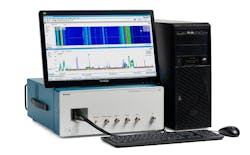Getting Looped into Hardware-In-The-Loop
In a recent announcement, Tektronix revealed that its RSA7100A wideband signal-analysis solution is now equipped with IQFlow functionality (see figure). This enhancement makes it possible to perform real-time digital signal processing (DSP) and support hardware-in-the-loop (HIL) testing for radar and electronic-warfare (EW) systems.
“Defense contractors in the U.S. are increasingly under pressure to get a more reliable, accurate assessment of how well the radar systems will deploy in a threat/response military environment,” explains Chris Loberg, senior marketing manager for the wideband solutions group at Tektronix. “They want that assessment to the extent that they can simulate the threat/response without actually physically running wartime exercises. HIL attempts to emulate that environment and provide a radar system designer with a more accurate assessment of what’s happening.”
Closely emulating a real-time environment is of paramount importance when it comes to HIL, according to Loberg. “The key is to get as close as possible to a real-time environment,” he says. “That enables a radar system that’s looking for a threat to confirm, with the highest possible degree of confidence, that the threat is there. The radar system should then be able to initiate a response in a manner that provides something that extinguishes that threat—in other words, a missile being activated or triggered in response to a threat being perceived as real from the radar system. That threat/response scenario is what we’re trying to help defense contractors deploy today.”
With IQFlow, the RSA7100A real-time spectrum analyzer can perform real-time digital-signal-processing algorithms and record/analyze long event sequences.
What were some of the roadblocks associated with this technology? Loberg notes, “The real-time nature has been out of reach. That’s primarily because the FPGAs lacked the processing speeds to accurately detect and provide the information to the system under test, for the system to then send out a response in a quick enough timeframe. The response must have all the directional and signal intelligence guidance necessary to go after the threat in a way that will extinguish it.”
“In the past,” continues Loberg, “with the lack of a real-time response, we contracted with and worked closely with large RAID (redundant array of independent disks) vendors to save all the detection sequences from the environmental warfare system in a recorded fashion. All the detected I/Q data was stored away on a RAID drive.
“The designers would later assess timing of threats. They would also have to determine if they could play back the data and reconstruct, so that response systems are triggered off the timing of the threat. But that would only happen in a non-real-time fashion. One would have to go offline and sort through hours and hours of data to find specific threats and then look at those trigger events as just that—triggers for the response stimuli.”
Tektronix asserts that IQFlow brings a new dimension to the table. Loberg adds, “With the announcement of IQFlow, we’ve now moved closer to modified real-time EW from an HIL perspective. With the enhancements made to the RSA7100A, we can provide access to the streamed I/Q data in real-time. Contractors can use the latest and greatest FPGA technology to get the system as close as possible to a real-time state. That effort is taking place right now on the east coast with one defense contractor. As these firms are armed with very fast FPGA capability, Tektronix with IQFlow is opening up the I/Q data for direct querying and assessment of threats.”
Loberg also mentions what Tektronix is planning to introduce in the future. “The next step for us is to provide the arbitrary waveform generators (AWGs) with the same capability. The AWG forms the response stimuli. In a modified system, it will send out a response to a threat like initiating into the spectral environment a pulse that would represent some deterrent device. We’re enhancing the ability of the AWG to receive and respond more quickly by opening up an Ethernet port on the instrument that will enable the FPGA controller to say it’s time to send out a response and identify the waveform type to send. The AWG would respond and play the role of the response emitter.”
Loberg sums it up with this: “The key takeaways are the closer to real-time the system can be, the more effective the EW simulation, and the lower the risks associated with live wartime simulation.”


